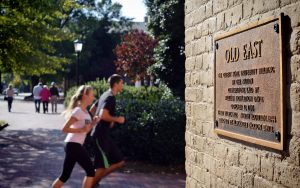History

The University of North Carolina was anticipated by a section of the first state constitution drawn up in 1776 directing the establishing of “one or more universities” in which “all useful learning shall be duly encouraged and promoted.” State support, it directed, should be provided so that instruction might be available “at low prices.” The American Revolution intervened, and it was not until 1789 that the University was chartered by the General Assembly.
On October 12, 1793, the cornerstone was laid for a brick building on a hilltop near the center of the state amidst the colorful fall foliage of dogwood, oak, and tulip trees. The site was marked only by a small Anglican chapel that soon shared part of its name—New Hope Chapel Hill—with the community that developed there. Legislator and trustee William R. Davie, who had been instrumental in securing passage of the charter, took the lead in organizing the University. Davie presided over the Masonic ritual of the laying of the cornerstone. In time he came to be called “the Father of the University.” Many years later a large poplar or tulip tree, first mentioned in 1818 and still standing near the center of the old campus, was called Davie Poplar in his honor.

The first building and, indeed, the only building for two years, was a two-story brick structure that came to be called Old East. It is now a National Historic Landmark, the oldest state university building in America. Opened to students on January 15, 1795, the University of North Carolina received its first student, Hinton James of New Hanover County, on February 12. By March there were two professors and 41 students present.
The next building on the Carolina campus was Person Hall, begun in 1796 and long used as the chapel. The cornerstone of Main or South Building was laid in 1798. All three are older than any other American state university building.
During the early 19th century the trustees began a period of strong support in the development of the young University. Even though their proclaimed initial goal for the University had been to provide trained leadership for the state, the curriculum followed the customary classical trend. In 1815, however, the natural sciences were given equal place, and in the 1820s Professors Denison Olmstead and Elisha Mitchell prepared the nation’s first geological survey. In 1831 the first astronomical observatory at a state university was built under the direction of President Joseph Caldwell. Enrollment increased steadily, and by 1860 only Harvard, Yale, and the University of Virginia had more students.
Young men from many states came to Chapel Hill for their education, particularly those from families who had recently left North Carolina to settle elsewhere in the South. The University of North Carolina provided governors not only for North Carolina but also for many other states; countless professions and occupations were represented among its graduates, including cabinet members, clergymen, diplomats, engineers, geologists, judges, legislators, surveyors, teachers, and a president and a vice president of the United States.
Though the Civil War closed many colleges and universities, the University at Chapel Hill remained open throughout the war, though its students were few. During Reconstruction, however, it was closed from 1870 until 1875. When it reopened, the University’s leadership began to inaugurate programs that once again marked it as a leading university.
The General Assembly in 1931 consolidated the University with the Woman’s College at Greensboro and North Carolina State College at Raleigh under a single board of trustees. As an economy measure during the Depression and as a means of eliminating duplication, the trustees allocated each unit specific roles in higher education for the state. The offices of the Consolidated University were established on the Chapel Hill campus and University President Frank Porter Graham became the Consolidated University’s first president.

The Depression era in the 1930s saw a great deal of new construction on the campus as federal funds became available to create jobs for the unemployed. New dormitories, classroom buildings, a gymnasium, and other buildings and improvements were built in part from this source. World War II also resulted in some new construction and alterations on campus as the University’s facilities were used to train military personnel.
Expansion continued throughout the 20th century, and today UNC–Chapel Hill ranks among the great institutions of higher education in the nation. Beginning with one building, 41 students, and two professors, the University has now grown to more than 300 buildings, more than 29,000 students each year, and nearly 3,800 faculty members. Carolina offers 78 bachelor’s, 112 master’s, 68 doctorate and seven professional degree programs through its 14 schools and the College of Arts and Sciences. The William and Ida Friday Center for Continuing Education serves adult learners through credit and noncredit course offerings.
This history is adapted from an essay published in the 1994 Faculty Handbook by Professor Emeritus William S. Powell. Learn more about UNC’s history at the History and Traditions web page, or visit The Carolina Story: A Virtual Museum of University History for self-guided digital exhibits. University Archives and Records Management also maintains a vast collection of historical records in the Louis Round Wilson Library.

